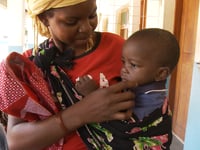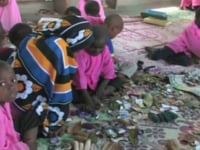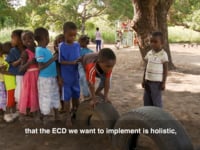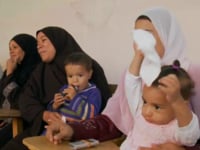3.1 Listening to families and communities
Variations in children’s development and learning are shaped by cultural values, but they are also strongly linked to economic and structural inequities, as these impact on the capacities of parents to promote their children’s development. Supporting the child’s development entails both respecting and supporting the family and community which carry the major day-to-day responsibility for the child. Young children’s close relationships offer the immediate context for all aspects of their development and learning, and introduce them to the cultural tools through which their knowledge and understanding grow, notably language” (Brooker & Woodhead. 2010, p. 1).
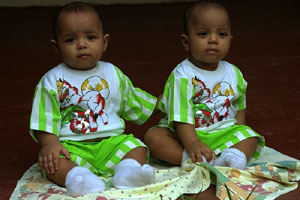
Early childhood programs are best developed with full awareness of existing local culture, values, initiatives, and strategies. The families who benefit most from ECD programs are those who are able to integrate them into their existing daily life and routines. Programs can be structured as partnerships with families and invite participation by parents and caregivers. Parents and other primary caregivers bring intimate knowledge about each child and his or her family and cultural context.
Listen as Dr. Rael Ogwari, lecturer in the Department of Educational Psychology at Moi University, describes the importance of understanding and respecting local community values and childrearing practices when developing programs and also in conducting research.
Ogwari describes the tradition of wrapping and carrying a baby on the back of an adult, usually the mother, and the many benefits of this practice. Filmed in Mozambique, the next video is a brief collage of mothers carrying and interacting with their closely wrapped babies.
In this next video, listen as Immaculate Salaon, former Child and Health Development Officer, PATH Kenya., describes an example of working with a community to implement simple changes to their beneficial childrearing practice of massaging babies.
Baby wraps and massage are two examples of cultural practices in childrearing. What cultural practices exist in your context?
How do they support children’s development?
When they might be harmful, how might you help parents tailor their practices?
Local communities are well-positioned to have input into the curriculum and scheduling of programming to meet local realities. Dr. Alan Pence, the UNESCO Chair for Early Childhood Education, Care and Development at the University of Victoria, is a strong proponent of ensuring that community members are intimately involved in designing, developing, and implementing programs that will influence their children.
Pence also stresses the importance of awareness when working with communities other than one’s own.
Do you agree with Pence’s comments? Why or why not?
Why does Pence advocate for the inclusion of local culture and context in the design and implementation of ECD programs?
Why is community involvement important at every stage – design, implementation, monitoring and evaluation?
In your context, are communities’ needs factored into the design, implementation, monitoring, and evaluation of ECD policies, programs, and research? If yes, how? If no, why not?
We need reflective and well-informed practitioners, who do not assume there is one best practice which suits all, but who are able to recognize, explore, and discuss the arc of human possibilities” (Penn, 1999, p. 4).
Involving community members in the assessment of their needs and the development of programs to meet their needs, helps build social capital. The central premise of social capital is that “social networks” have value. It refers to the collective value of all social networks – who people know – and the inclinations that arise from these networks to do things for each other (Putnam, 2000).
Social capital in action can be found when people voluntarily come together to build the capacity for early childhood programs in their communities and neighbourhoods. Madrasa preschool programs in Kenya, Tanzania’s Zanzibar region, and Uganda are examples of community-based early childhood programs for children that build social capital in the respective communities. Listen as Najma Rashid, early childhood development technical advisor for the Aga Khan Foundation – East Africa, describes how these programs began.
The following short program is about the Madrasa programs marking their 25 year anniversary.
For information celebrating the twenty-five-year history and ‘lessons learned’ from the Aga Khan Foundation’s Madrasa Early Childhood Programme Project, read the following report:
Program examples
There are many innovative ECD programs around the world that reflect the priorities of their specific communities. As you learn about the following examples, consider what makes each culturally-specific as well as what they have in common.
Filmed in a village in northern Mozambique, the next video highlights how local community members were consulted on the development, and are involved in the community ECD program. As you watch, notice the aspects of the program that are characteristic of the local culture – for example, the call and response that occurs throughout the morning.
The following video profiles a fascinating pilot kindergarten program for young children in Kyrgyzstan that was developed to accommodate families’ farming migration patterns of moving to mountain pastures in the summer. The kindergarten program makes extensive use of community wisdom and takes pride in teaching children the traditional lifestyle and culture of the Kyrgyz people. They also use a very interesting agricultural approach to making the program sustainable.
Think about these rural Kyrgyz children’s lives – their culture, the landscape in which they live, their educational opportunities, and the economics of the area. In what ways do the yurt kindergartens meet the particular needs of these children and families?
The next video shows an example of an ECD program in villages in southern Egypt, designed to support mothers of young children, strengthen their understanding of child development and positively influence their interactions with their children. This program takes place in the community and provides a valuable social opportunity for women to get together outside their homes.
In what ways does each program “listen” to families and communities?
What do you see as the goals for each program? What do they have in common and how do they differ?
Think about both sustainability and scaling. What may be some challenges for these programs?
Many societies consist of a blend of cultures – living in various degrees of harmony. Cultural survival is a concern for some societies, especially Indigenous peoples. This video is about the efforts of Indigenous communities in Canada to strengthen the cultural identity of their people, beginning with early childhood programs.
Listen to Dr. Cindy Blackstock, executive director of the First Nations Child and Family Caring Society and a professor at McGill University’s School of Social Work, discuss how she thinks Indigenous people around the world share many beliefs.
Some of the fundamental values Blackstock speaks about are:
- listening to and honouring past knowledge;
- the idea that all of life is interconnected and we need to help children understand this; and
- living to contribute goodness to the future rather than thinking about being remembered.
What do you think we can learn from these ideas?
Are these values prevalent in the dominant cultures where you live today?
Do you feel programs honour these Indigenous values? In what ways?
Read about how cultural contexts are reflected in programs in various countries in the Bernard van Leer publication Early Childhood in Focus 6: Culture and learning.

